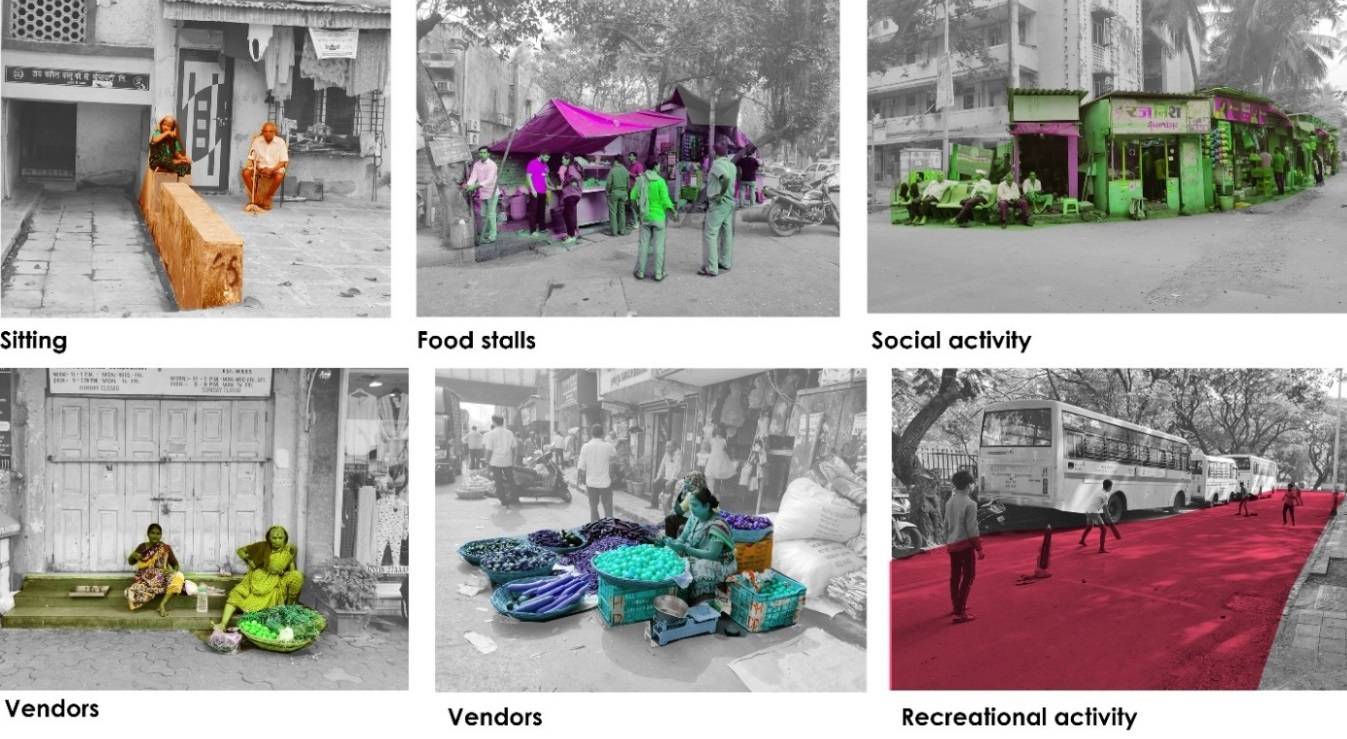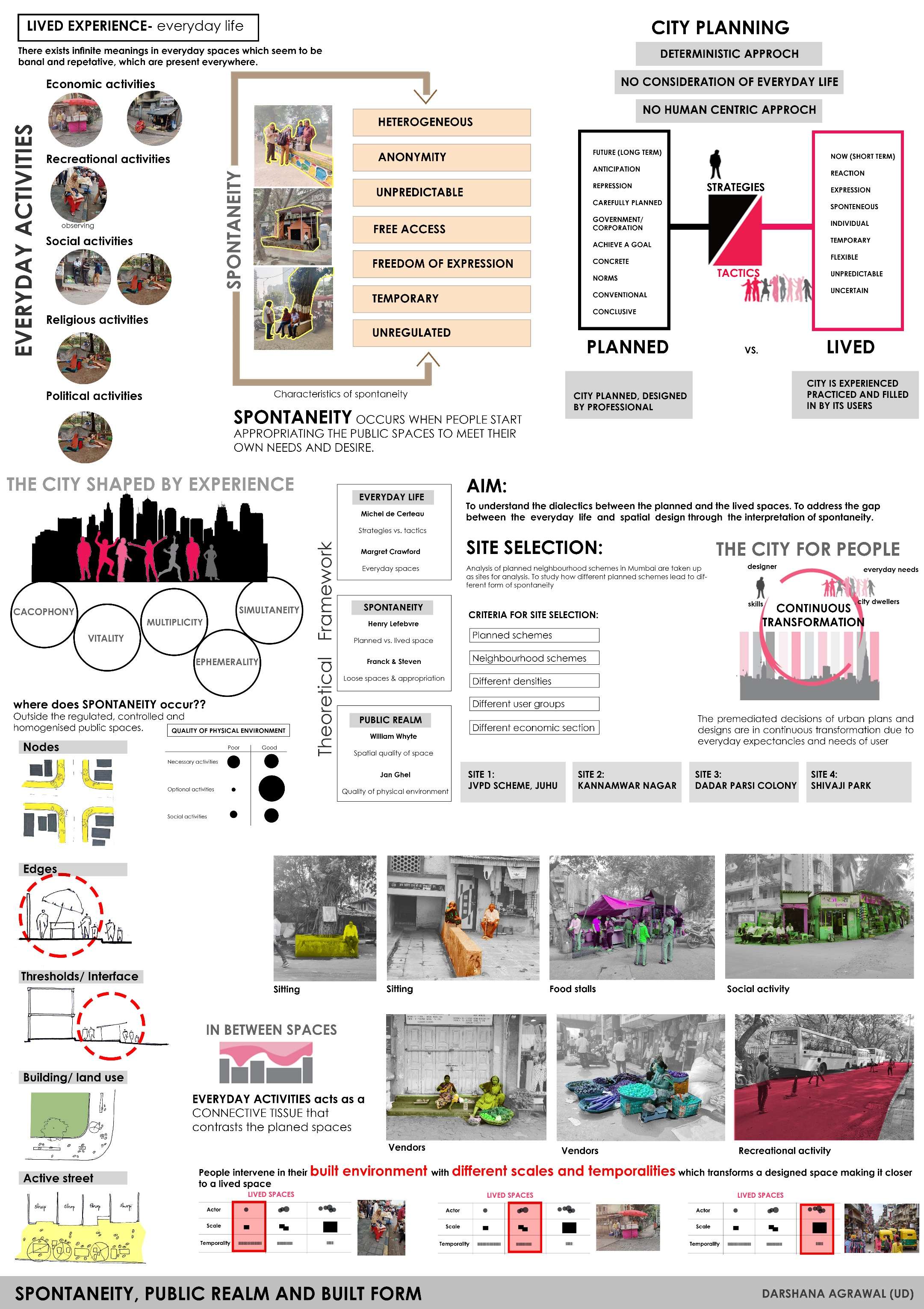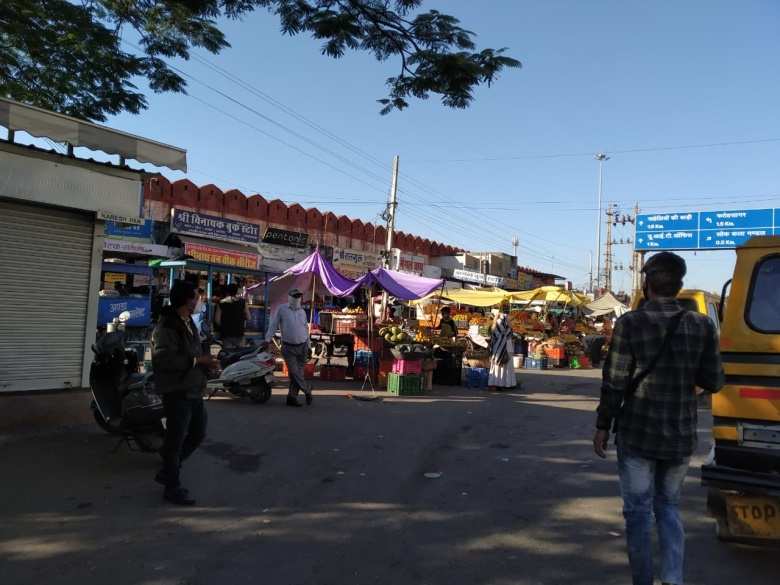Udaipur - The vitality of spontaneity and informality in public realm
Global forces have influenced new narratives of cities in recent times. It explores the presence of cultural capital and social infrastructure owing to vast historic significance of Indian cities; the struggle to strike a balance between preserving tradition and modern convenience. The historic Indian cities are emblems of active urban tissues that are facilitated by activity and people in an urban space. The vibrant nature of Indian historic cores is due to the presence of various urban actors, systems and their inter-linkages.
It is the embedded informality in the urban spaces that add to the local culture, flavour and intrinsic urban language. The enmeshed informality gives cultural quarters and territories a quintessential flavour to enhance the urban pattern and tissue. The everyday urbanism is one of the biggest cultural asset to any Indian city where formal and informal intersect culturally and spatially. From the tea stalls at the corner of the street to a local flower vendor, the spatial nuance of informal and everyday activity adds to the formation of cultural phenomena. The tangibles and intangibles are morphed and moulded to form memories, phenomena and to evoke a sense of space through experiential and sensory toolkits.
The current era of globalization with its acceleration in global flows of capital labour and information has a strong impact on local cultures. While these phenomena have promoted integration of societies and has provided new opportunities, it may also result in loss of local identity – formal and informal.
Informality establishes the contestations within the identities – of people, of place, of the plural nature of Indian cities. These newer cultural practices intersect with political, economic and social dynamics at all the levels of social hierarchy. The implied or explicit significance of certain traits, activities and places explain its association with the group or an individual leading to formation of physically defined or undefined cultural quarter. How a space is perceived, how a space is experienced and how it transforms and adapts over time is a critical argument in visualizing these changes. Certain tangible and intangible features like architecture, urban fabric, historic significance, sense of place, memories, practices and rituals, help us understand what the space means to the individual and what an individual means to the space.
Informality in Indian cities is subdued in its everyday spaces and everyday urbanism. "Everyday" is a manifestation of the ordinary life, routines and reality in a city, characterized by cacophony, multiplicity and simultaneity, as unsettled, restless conditions experienced in everyday life. It is "an approach to urbanism that finds its meaning in everyday life" and its experiences. It attempts to connect human and social meanings to urban design and planning.
Everyday life, in a sense residual, characterized by what is left over after all distinct, superior, specialized, structured activities have been singled out for analysis, must be defined as a totality. Considered in their specialization and their technicality, superior activities leave a technical vacuum between one another which are filled by everyday life.

While social science possesses the ability to study the traditions, language, symbols, art and articles of exchange that make up a culture, it lacks a formal means to examine the ways in which people re-appropriate them in everyday situations. "Ordinary" practices of everyday life like walking, dwelling, cooking and talking - are the creative resistances of people. Individuals navigate through life in their own way, thereby changing existing rules, structures and territories, which Michel de Certeau (1984) has called the "Practice of Everyday Life." These resistances are termed as 'tactics'.
"Everyday urbanism is an approach to urbanism that finds its meanings in everyday life" and its experiences (Mehrotra, 2004). It finds rich meanings and extraordinary actions in otherwise ordinary and often mundane routines of everyday life. It also emphasizes the importance of the public realm as a place of everyday activities. Connection between everyday life and the public realm is established through an everyday space a space that is constructed spontaneously between defined and undefined realms of home (private or first places), and institutions, workplaces (public or second places). Through the notion of everyday space, studies in everyday urbanism attempt to re-establish the neglected connection between the human meaning of everyday urban environments and the public realm. The assumption behind such a space is the vitality of everyday public activities.
The approach regards everyday functional spaces as a zone of possibility and potential transformation of publicness. Though the everyday space is descriptive and generic, close observation highlights inhabitation, action, and appropriation. Situational and specific qualities of the everyday experience can be recorded through naturalistic observation of people. The users' point of view is vital in such a public realm to addresses informal and spontaneous utilization of space together with the formal and designated functions. Considering the public realm as a human construction, human appropriation and interpretation of publicness in different types of everyday public places must be examined. Such an empirical approach builds on daily life and the everyday practices.
The premeditated decisions of urban plans and designs are in a continuous transformation due to the everyday expectancies and needs of users. People mostly intervene in their built environment in differing scales and temporalities which simultaneously transform a designed space and making it closer to a lived space. Therefore, the emergent user spaces and social practices that occur throughout the everyday life dynamics beyond the expectations of an urban plan are significant to develop a human-centred viewpoint for urban planning and design studies.
The physical and social making of spaces by everyday users is seen as the actions that make an urban space a living entity in any settlement of the world. They are realized in the designed physical environments enriching and transforming them through particular social and spatial operations. Despite the ephemerality and complexity, they present a substantial input for urban planning and design for they refer to a common human nature of making space by living. However, they are either taken for granted as the outcome of design, or merely accepted as ordinary actions occurring here and there without disturbing the main structure. Therefore, everyday urban life and space is overshadowed by a macroscopic reading of urban life.

Parameters to decode the spontaneity are -
1. Accessibility: Accessibility can be defined in terms of physical accessibility and on the basis of certain class structure or other criteria.
2. Gender/ age: the gender defines the proportion of its usage by people of different genders and the age structure of people using it.
3. User group: User group helps to understand which type of user maximises in which type of space, thus allowing us to design the space accordingly.
4. Temporal nature: The temporal nature defines the intensity of usage of that space during different times and the gender defines the proportion of its usage by people of different genders.
5. Degree of sociability: It describes what the nature of relationship of people interacting in that place is. From passive contacts to close friends, it defines the degree of sociability.
6. Density: Density defines the amount of people utilising that space
7. Visual accessibility: It describes how the activities as visually connected, highly visible or hidden.
8. Urban furniture: Urban furniture helps to understand how it encourages social interaction within the public realm.
9. Spatial configuration of that place: Design features highlight the actual elements of the built fabric involved in interaction.
10. Spatial distribution of people/ activity in that place: It describes how the activity is spread spatially, where the activity is concentrated and the flow of the activity.
Based on the above parameters, spontaneity can be categorised as following.

1. Appropriation at nodes
There is always a variation in activity observed at the nodes as they form the focal point of changing activities. A node, a ‘katta’ in the regional language forms an important part of the everyday life of an individual; this is a place where the crowd of all age groups interact, a place for social exchange, to make passive contacts. Node forms the smallest element of social interaction of a city. A node of any street is always vibrant with activities as it forms the transformation point. Public open spaces at nodes are formed in educational areas for the youngsters, near bus, taxi, rickshaw stands as relaxation points for the drivers. Shastri circle, Surajpol, Jagdish Chowk, Hathipol, Delhi gate, RK circle, Shobhagpura circle are a few examples where one can see appropriation. It is here where everyday urbanism in Udaipur is at its peak.
2. Due to certain amenities
Certain building uses affect the formation of certain types of public open spaces. An institutional building leads to formation of a layer of public open space outside its boundaries to bank upon the commercial potential while a residential area leads to the formation of public open spaces on the inner streets to provide a space for social interaction and sense of security. The spontaneous informal kiosks at the edge of Pahadi bus stand and Gandhi Darshak Mandap are examples of the same. The vegetable mandi in the inner areas of Delhi gate exemplifies these spaces in the open chowks that are formed due to existing built fabric.
3. Edges/ thresholds
Thresholds are commonly perceived as transitional spaces between public and private spaces. Whyte (1980) and Stevens (2007) also acknowledged that thresholds are special boundaries with considerable behavioural potential. Both of them theorized thresholds as potential contact spaces where strangers are gathered by necessity when moving through them and are forced into close proximity.
Edges are usually defined as a type of boundary that has a function of dividing and structuring the inside and outside (Bentley et al. 1985). When people are in a public space they tend to sit first at the edges of that space. However, the empirical findings showed that edges could fulfil many other social uses and attract a variety of users. They can become the best spaces of retreat, fulfilling the desire for privacy, if they are of the type of passive edge (e.g. water or green spaces) or enclosed building or seating edge where people can just rest and contemplate. Sennett contends, “the edge-as-border is a more open condition means it is more full of events in time” (Sennett, 2009).
Sennett forces designers to consider how public spaces can be opened up, how the divide between inside and outside can be bridged and how visual form can invite engagement and identification (Sennett, 2006). Sennett believes that “openness can be planned” (Sennett, 2009) and that “in the public realm, openness can be defined in terms of built fabric and its context” (ibid.).
The food market at the rigid edge of Fateh Sagar is the best suited here. The edge attracts crowds of all ages and communities to partake in formation of place making. The edge condition at the threshold of planned open spaces like Mohata park also brings in spontaneous activities in from of barbers, snack stalls, tea stalls to serve the commuters and visitors using Pahadi Bus stand as a service port.
4. Peripheries
Peripheries here mean the boundaries of the planned scheme and the way it is connected and appropriated by the rest of the city. As the planned schemes do not always fulfil the demands and needs of its users, these activities seem to concentrate on the peripheries of the schemes as due to the over determined form it does not always allow to accommodate within it. For example, the Ashok Nagar main road and Bapu Bazaar are commercial streets on the periphery of planned residential colonies like Ashok Nagar, Shakti Nagar and Nada Khada respectively. As these areas were designed as a purely residential zone, it could have led to the formation of the markets to fulfil the daily needs of people.
Udaipur has informality and spontaneity enmeshed in its morphology. The chowks and nukkads of old city, the threshold of various pols, the entrage of temple precincts have acted as the spaces of everday urbanism. Ghats, Streets and city gates have contributed significantly to spatialize the informal with planned formal interface. Mixed landuse, High density and congregational communal activities also add to the phenomena of place making via informality in old quarters.
However in Udaipur, with the advent of creating ‘planned spaces’, the notion of ‘lived spaces’ have been pushed off the radar. Seemingly, these areas that have been devoid of the inclusion of informal conditions in their formal set up are the ones where appropriation, encroachments and spontaneous activities sprout to serve people with their daily needs. The premeditated decisions of urban plans and designs are in a continuous transformation due to the everyday expectancies and needs of users. People mostly intervene in their built environment in differing scales and temporalities which simultaneously transform a designed space and making it closer to a lived space. Therefore, the emergent user spaces and social practices that occur throughout the everyday life dynamics beyond the expectations of an urban plan are significant to develop a human-centred viewpoint for urban planning and design studies.
Hence city planning should recognise spontaneity as an essential factor for every space and take long term and short term measures for the same. Temporary and permanent design interventions can make a public space more inclusive and also enhance the quality of life of the people.
About the Author
Trained as an Architect (Honors in B. arch, Gold medallist; JNVU) and an Urban designer (kRVIA), Daksh Jain is a resident of Udaipur. His interests traverse in the domain of Urban planning, Urban design, Heritage conservation, Development finance and Policy framework. His works in academia follows the lines of Sociology, Ecology, Economics, Cultural studies, Informality and inclusive public oriented designs.
Currently, he is working as an independent researcher on the topic- City life, Culture and Consumption – Emerging urban phenomena.
He is also the recipient of Bhamashah Award for excellence in Academics by Eternal Mewar,Maharana Mewar Foundation in 2019.
About the co-author (Darshana Agarwal):
With her prime interest in creating accessible and inclusive public spaces, Architect & Urban designer Darshana Agarwal advocates for people oriented design of urban spaces. Hailing from city of Nashik, she has her advocacy that revolves around legitimizing spatial informal practices and curating sensory urban experiences.
An avid traveller and enthusiast for photography, she documents the everyday urban phenomena of her travelled places through photo-vice and interaction with locals. Her portfolio favor the third and fourth place theory based in public spaces and zones of sociability. She works in the lines of active urban tissues, formal & informal interfaces, inclusive neighborhoods and streets.
To join us on Facebook Click Here and Subscribe to UdaipurTimes Broadcast channels on GoogleNews | Telegram | Signal



